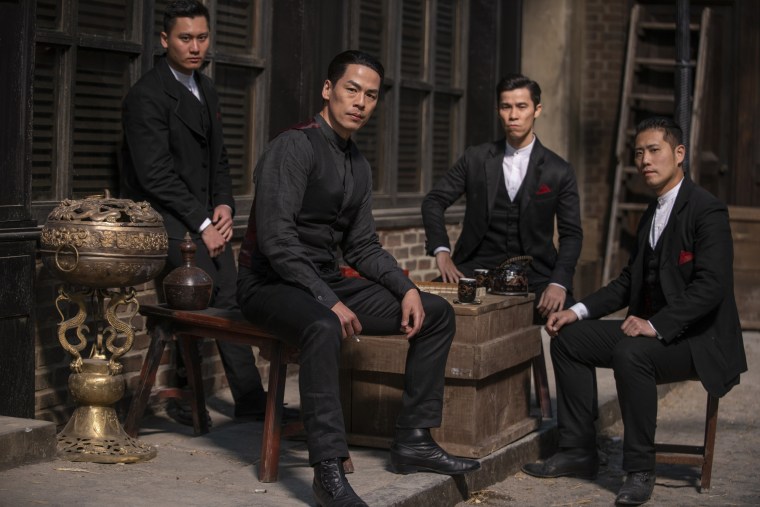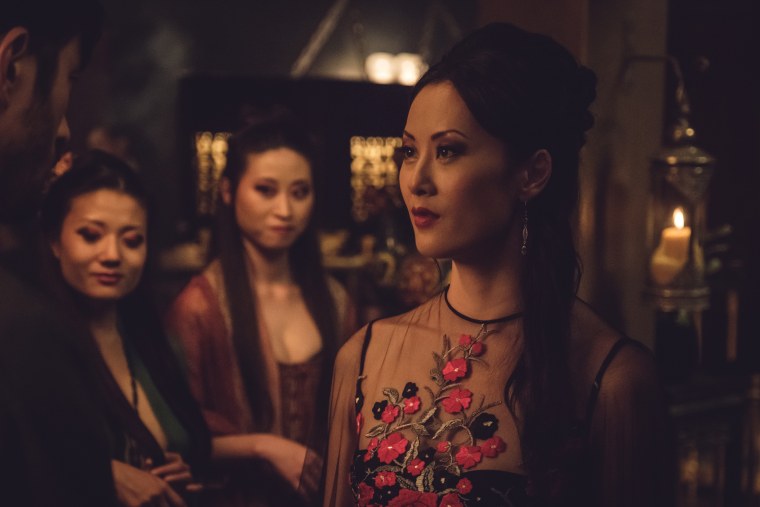Almost 50 years after Bruce Lee said studio executives wouldn't make his TV show pitch, which he attributed in part to their unwillingness to cast an Asian lead, Cinemax is bringing the legendary martial artist's project to life.
Lee's original pitch, "The Warrior," featured a Chinese martial artist exploring the American West. In 1972, about a year after the studios to whom Lee brought the project declined to make the show, "Kung Fu" starring David Carradine as a martial artist exploring the American West began to air.
Filmmaker Justin Lin ("The Fast and the Furious: Tokyo Drift," "Star Trek Beyond") remembers watching "Kung Fu" as an 8-year-old new immigrant from Taiwan and being confused.
“I was like, ‘Why is there a Caucasian man speaking in broken English?’” Lin said at a press event. “It stayed with me.”
The story of Lee's efforts to make "The Warrior," which came from an interview aired on Canadian television that he did in the 1970s, also stayed with Lin. The pursuit of Lee's project led Lin in 2014 to meet with Shannon Lee, the actor's daughter and the steward of his notes and papers. "The Warrior" existed: The documents sat in a box in Shannon Lee’s office, and she showed it to Lin.
That meeting ultimately led to the development of “Warrior,” a TV series scheduled to premiere on Cinemax on April 5. The show follows martial arts prodigy Ah Sahm (played by Andrew Koji) as he travels to San Francisco in search of a woman the audience has yet to meet. There, Sahm gets caught up in a conflict between rival Chinatown gangs.
“I felt like there was an opportunity to correct a wrong, to really try to honor what he was trying to do,” Lin, an executive producer of the show, said referring to Bruce Lee.

In addition to the central storyline, “Warrior” explores the post-Civil War West in the years before the passage of the 1882 Chinese Exclusion Act. Early episodes touch on rising tensions among Irish laborers, anti-immigrant sentiment targeted at the Chinese, and politics and business in a growing San Francisco, among other topics.
Chinese history in the United States — from the gold rush to work on the transcontinental railroad — regularly appear, in part in an effort to introduce viewers to a period of history that the filmmakers said is rarely represented, even in schools.
“Watching Westerns growing up, you’re like, ‘Wait, there’s Chinese Americans in the West, but they’re always like extras,” Lin said. “And history classes, you’re lucky to have two sentences about the Chinese-American experience.”
“I felt like it was important to kind of build the show and hopefully have layers,” he added. “If you want to engage with it on an entertainment level, hopefully it’s there, but we also worked really hard to make sure all the other elements — the historical aspects — are built in there.”

To construct the setting for the show, executive producer and writer Jonathan Tropper said he did much of his own research to learn about aspects of history he hadn't gleaned from school, such as the ways U.S. companies recruited in China and the dangerous and difficult conditions that Chinese laborers experienced.
“It was about a time in history I didn’t really know about,” Tropper said.
The production team also made an effort to ensure that the show featured Asian Americans both behind and in front of the camera. According to Tropper, two members of the writers room are Asian American. Of the first nine episodes, two credit an Asian-American writer and three credit Asian-American directors.
The way the Chinese characters speak is also intended to have the audience identify with them. While the show’s politicians and Irish characters speak period-appropriate English, the Chinese characters — who canonically speak Cantonese to each other — have a modern English vocabulary when on screen.
Though the show touches on several modern themes, Shannon Lee said the decision to explore these ideas was her father's.
Bruce Lee’s original treatment was updated for modern TV-making, with a grittier, more stylized and comic book-like feel, Lin said. As for the setting, Bruce Lee liked to explore different Chinese experiences in his work, his daughter noted. Bruce Lee's “The Warrior” was set in San Francisco due to his interest in the early Chinese immigrant experience.
“This is my father's idea, but the treatment he wrote was for 1970s episodic television, and we're not there anymore,” Shannon Lee said. “I didn't want to be too overly precious about it. I want to do something that audiences of today will respond to and … be able to weave sort of the legacy of my father throughout the show.”
That is something Shannon Lee has worked to preserve as CEO of both the entertainment company and a nonprofit foundation that bears her father’s name. It has been difficult on occasion, she acknowledged, as some people have different emotional connections to her father than she does.

For instance, Bruce Lee recently appeared as a character in the trailer for the upcoming Quentin Tarantino film, “Once Upon a Time in Hollywood.” Shannon Lee said her family was not contacted about the portrayal, and she has concerns about whether her father will be depicted as a whole human or as a caricature.
“It’s something I’ve had to get used to,” she said of people’s relationships with her father. “When I first started running the business, I used to get really incensed and upset all the time because other people think of him as a commodity and he’s my dad.”
But over time, she has learned to focus on her father’s legacy and philosophies, both which are represented in "Warrior," primarily through the development of the main character, Ah Sahm.
“What I love about what Bruce Lee was trying to do is that this was a show about establishment, structure — even in the way Ah Sahm fights,” Lin said. “In his way, being an American, having this American experience, he creates a new philosophy.”
Follow NBC Asian America on Facebook, Twitter, Instagram and Tumblr.

